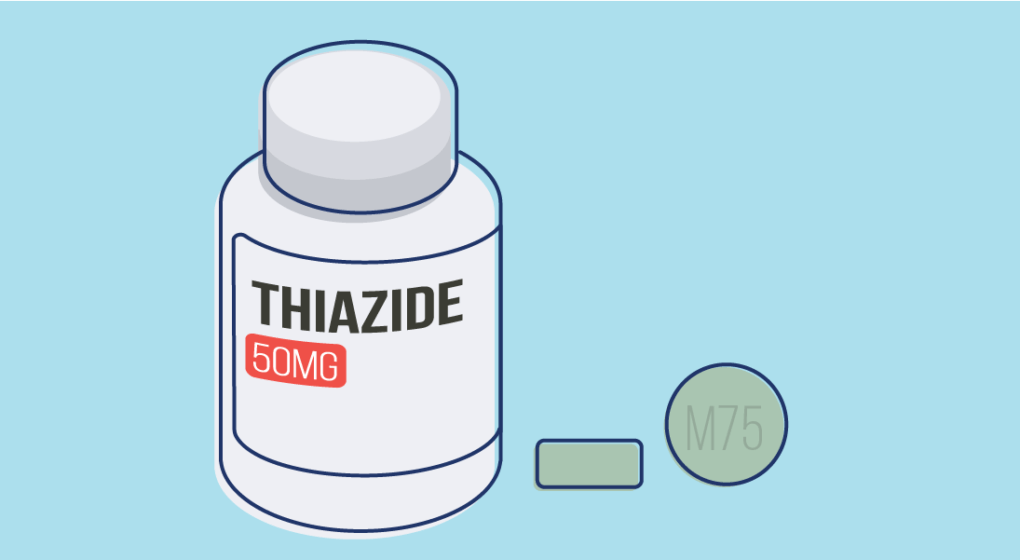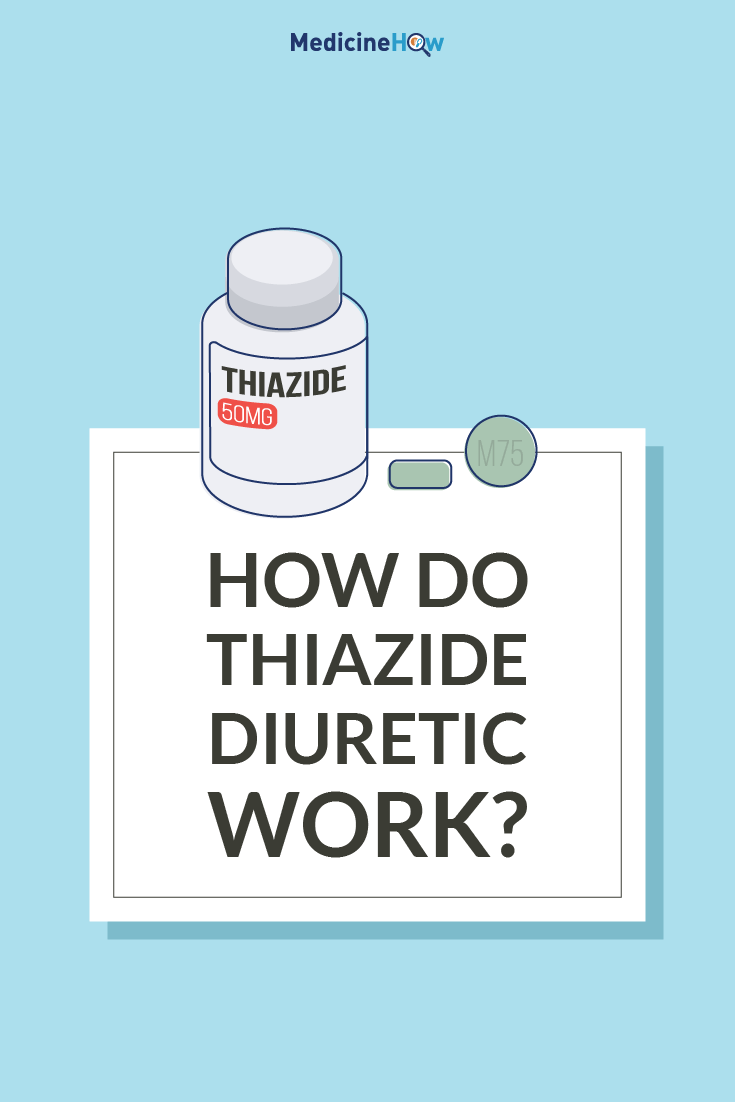
Thiazide diuretics are a class of drugs that work by changing the reabsorption of sodium in the kidneys, leading to more fluid being excreted from your body in your urine. They also have an effect on the muscles surrounding the blood vessels in you body, causing them to relax and allow blood to pass through more easily, which is helpful in the treatment of hypertension.
It’s not just high blood pressure that thiazide diuretics can be used for, though. They can also help if you have oedema (swelling due to excess fluid) or a specific type of diabetes.
Thiazide Diuretic Drugs
There are a few different drugs that work in a similar way, known as thiazide diuretics or thiazide-related diuretics. These drugs include:
- Chlorthalidone (e.g. Hygroton)
- Hydrochlorothiazide (e.g. Dithiazide)
- Hydrochlorothiazide with triamterene (e.g. Hydrene)
- Indapamide (e.g. Natrilix, Dapa-Tabs, Insig)
Each of these drugs in different (they are a different chemical substance) but they way they work in the body is very similar, which is why we group them together as a “class” of drugs.

What can they be used for?
As thiazide diuretics have a range of effects on the body, both in the kidney and on smooth muscles around the body, they can be used to treat several different health conditions. Your doctor might have prescribed a thiazide diuretic for:
- Oedema (build up of fluid) with heart failure
- Oedema (build up of fluid) with hepatic cirrhosis
- Mild to moderate hypertension
- Nephrogenic diabetes insipidus
Why do they help with these conditions? Let’s take a closer look.
How do they work as a diuretic?
The diuretic effect of thiazide diuretics is useful if you have oedema or nephrogenic diabetes insipidus.
In a healthy person, the kidneys constantly filter the blood in the body. Most of the blood enters into the nephrons (everything except the “big” molecules like proteins) and then your body reabsorbs the things you still need, like nutrients and fluids, back into your blood. In the end, only the things your body doesn’t need make it to the end of the nephrons and are excreted in your urine.
Thiazide diuretics change the reabsorption of certain things in your urine, making you urinate more often. Specifically, they block sodium and chloride salts from being reabsorbed, which means more of these comes out in your urine. Water usually “follows” sodium in the body to dilute it – so if more sodium is excreted, more fluid is excreted, causing the diuretic effect. There are also changes to the reabsorption of potassium and magnesium salts in the body.
How do they work to manage hypertension?
 Hypertension, or high blood pressure, is a health condition that affects many people and is worrying because it increases your risk of cardiovascular events, like a heart attack or stroke. This is because the pressure is too high, placing too must stress on your heart and the rest of the cardiovascular system.
Hypertension, or high blood pressure, is a health condition that affects many people and is worrying because it increases your risk of cardiovascular events, like a heart attack or stroke. This is because the pressure is too high, placing too must stress on your heart and the rest of the cardiovascular system.
The main action of thiazide diuretics to lower blood pressure is due to their effect on smooth muscles throughout the body. These muscles form a case around the blood vessels and the medication causes the muscles to relax. When the muscles are relaxed, the blood vessels expand, allowing the blood to pass through the passageway more easily. With more room inside the blood vessels, the pressure drops slightly to help decrease the blood pressure and relieve the stress on the heart.
This effect can help to manage mild to moderate blood pressure, but for more severe hypertension, other medications are often a better choice.
Side Effects
Thiazide diuretics have several effects on the body and can cause side effects in some people. It’s a good idea to know what the most common effects are so that you can recognise them if they affect you.
Salt Imbalances
 The main action of thiazide is to alter the reabsorption of salts as the kidneys filter the blood to produce urine. This is useful to get rid of excess fluid, but can also cause imbalances in the concentration of these salts in the blood. You may experience:
The main action of thiazide is to alter the reabsorption of salts as the kidneys filter the blood to produce urine. This is useful to get rid of excess fluid, but can also cause imbalances in the concentration of these salts in the blood. You may experience:
- Low sodium levels (hyponatremia)
- Low potassium levels (hypokalemia)
- Low chlorine levels (hypochloremic alkalosis)
- Low magnesium levels (hypomagnesemia)
Each of these changes occur because the reabsorption is blocked too well and there isn’t enough of the salts in your blood. This can cause side effects like fatigue and weakness.
If you think you may be affected, you can ask your doctor for a blood test to test the levels in your blood.
Low blood pressure (hypotension)
It is also quite common for side effects to occur if the drug is working too well and you end up with low blood pressure, which can make you feel dizzy or weak. This often occurs when you first start taking the medication and then gets better after a few days. If you find your blood pressure is still too low after a week, your should check with your doctor that the dose is right for you.
Other Effects
You may also notice a range of other effects, such as:
- Muscle cramps
- Frequent urination
- Abnormal glucose levels
For the complete list of side effects, you should see the medicine information leaflet inside your medication.
Cautions
 There are a couple of things you should be aware of before you start taking indapamide:
There are a couple of things you should be aware of before you start taking indapamide:
Gout – Indapamide can increase the risk of gout because it increases the concentration of uric acid in the bloodstream, which is involved in causing gout. If you are prone to gout, an alternative medication may be a better choice.
Renal Impairment – Indapamide is less effective and may cause harm if you have severe renal impairment, due to its effect on the kidneys and renal function.
Drug Interactions
When thiazide diuretics are used with other drugs that help to lower blood pressure and manage hypertension, they may cause blood pressure that is too low. There are also some other specific interactions:
ACE Inhibitors + Thiazide Diuretics Interaction
In particular, ACE inhibitors and thiazide diuretics taken together are likely to cause low blood pressure, particularly for the first few doses. It is best to stop taking the thiazide diuretic for a few days when beginning to take a new ACE inhibitor drug.
Lithium + Thiazide Diuretics Interaction
Thiazide diuretics can decrease the amount of lithium that is excreted from the body, increase the concentration in the body and the risk of side effects. This combination is not recommended unless the concentration can be closely monitored.
Loop Diuretic + Thiazide Diuretics Interaction
Taking a loop diuretic drug with a thiazide diuretic can increase the risk of renal impairment and upset the balance of salts in the blood. Small doses of the thiazide diuretic and monitoring for problems is best.
NSAID + Thiazide Diuretics Interaction
NSAIDs and thiazide diuretics should not be used together unless the blood pressure, renal function and weight are closely monitored, so that the dose of the thiazide diuretic can be adjusted according to the results.
Additionally, hydrochlorothiazide can interact with bile acid binding resins, reducing the efficacy of hydrochlorothiazide. Simply separating the doses can help to avoid this.

Pregnancy and Breastfeeding
Thiazide diuretics should not be used by women who are pregnant or planning to become pregnant, as it may upset the balance of salts in the blood and has the potential to cause harm to the baby.
Thiazide diuretics can usually be taken while breastfeed, although low doses are recommended as small amounts may be excreted in the breast milk. It’s unlikely, but thiazide diuretics may also affect the milk supply by suppressing lactation.
Pin it!


